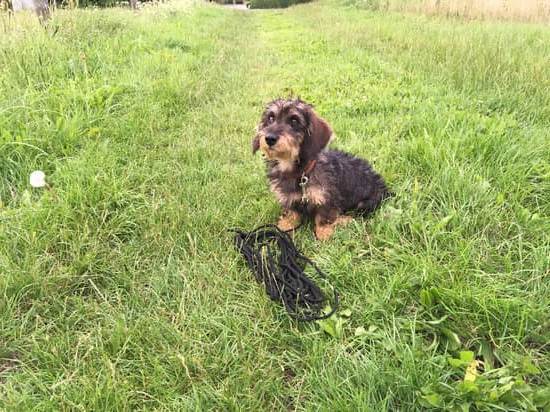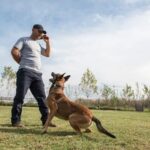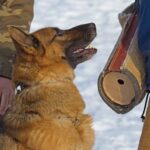Training a dog that jumps and bites kids can be a challenging and concerning issue for many dog owners. The safety of both the child and the dog is of utmost importance, making it vital to address this behavior promptly and effectively. In this article, we will explore why dogs may exhibit such behavior, the potential dangers it poses, and how understanding the problem is key to finding solutions.
Dogs may jump and bite kids for various reasons. It could be due to fear, lack of socialization, or even excitement. Regardless of the cause, it’s crucial to recognize that these behaviors can have serious consequences. A jumping or biting dog can accidentally harm a child, causing physical injuries or leaving emotional scars that may last a lifetime. Understanding why dogs engage in this behavior is the first step towards effective training.
By assessing the situation, owners can gain insight into their dog’s temperament and identify triggers for such behavior. This evaluation allows them to tailor their approach accordingly and create a training plan specific to their dog’s needs. Setting clear boundaries and consistent rules is essential in establishing control over the dog’s behavior. Redirecting their actions through positive reinforcement techniques can help them develop alternative behaviors that are more appropriate.
Socializing the dog gradually with children under careful supervision is another aspect of training that should not be overlooked. By managing encounters thoughtfully, using distractions creatively, and seeking professional help when necessary, owners can ensure a safe environment for both their pet and young ones. Building trust between the child, caregiver, and the four-legged family member creates a positive relationship rooted in love.
Assessing the Situation
Before addressing any behavioral issues in dogs that jump and bite kids, it is crucial to assess the dog’s temperament and triggers. Understanding why a dog behaves this way will help in developing an effective training plan. By evaluating the dog’s temperament and identifying its triggers, owners can gain insight into the underlying causes of the behavior.
To evaluate a dog’s temperament, it is essential to observe their behavior in various situations. Look for signs of fear, anxiety, or aggression when they interact with children or other stimuli. It may be helpful to keep a journal documenting these behaviors along with any relevant circumstances or events that may have triggered them.
Identifying triggers is equally important as it helps pinpoint what stimulates the dog to jump and bite kids. These triggers can vary from certain movements, loud noises, crowded spaces, or even specific individuals. By recognizing these triggers, owners can take measures to avoid or manage them effectively during training sessions.
To assess the severity of the issue, owners can use a checklist designed specifically for evaluating jumping and biting behaviors in dogs. This checklist should include categories such as frequency of incidents, level of aggressiveness involved, warning signs exhibited by the dog, and injuries sustained by kids. Having this information will assist owners in determining whether professional help is necessary or if they can handle the training themselves.
Assessing your dog’s temperament and triggers is an essential step in addressing their jumping and biting behavior. By gaining a deeper understanding of why your dog behaves this way, you can develop a more effective training plan tailored to their specific needs. Remember to prioritize safety during this process and seek professional assistance if needed for more severe cases.
Establishing Boundaries
When it comes to training a dog that jumps and bites kids, one of the key steps is establishing clear rules and consistency. Dogs thrive on structure and routine, and by setting boundaries, you can help them understand what behavior is expected of them. This not only helps to prevent jumping and biting incidents but also fosters a sense of security for both the dog and the children.
To begin establishing boundaries, it’s essential to first determine what specific behaviors are considered unacceptable. Is it jumping on people, mouthing or nipping, or both? Once you have identified the problematic behaviors, create a list of rules that clearly outline what is allowed and what isn’t. For example, you may decide that jumping on kids should be discouraged completely.
Consistency is key in reinforcing these boundaries. Make sure that all family members are on board with the rules and enforce them consistently. Dogs thrive when they have clear expectations, so be consistent in your response to their behavior across different situations. If one person gives in to jumping or biting while others discourage it, the dog will become confused about what is acceptable.
In addition to setting clear rules, positive reinforcement training methods can greatly assist in establishing boundaries effectively. Rewarding your dog with treats or praise for displaying desired behaviors such as sitting calmly rather than jumping can reinforce a positive association with following the rules. Training sessions should be short but frequent to maintain interest and focus.
By consistently enforcing clear rules and utilizing positive reinforcement techniques, you can help your dog learn what behavior is acceptable around kids. This will require patience and consistency over time but will ultimately lead to a well-behaved pet who understands their boundaries.
| Establishing Boundaries | Setting Clear Rules |
|---|---|
| Identify unacceptable behaviors such as jumping and biting | Create a list of rules outlining allowed and forbidden actions |
| Consistency is key in enforcing boundaries | All family members should be on the same page |
| Positive reinforcement training helps reinforce boundaries | Reward desired behaviors with treats or praise |
Redirecting the Behavior
In order to address the issue of a dog that jumps and bites kids, it is important to redirect their behavior towards more appropriate actions. By teaching them alternative behaviors, we can effectively eliminate the jumping and biting tendencies. Positive reinforcement techniques are key in this process.
One effective approach is to use a clicker training method. This involves associating a clicking sound with positive reinforcement, such as treats or praise. Here is how you can train your dog to exhibit alternative actions:
- Sitting: Teach your dog to sit on command by guiding them into a sitting position with a treat held above their head. As soon as they sit down, click the clicker and give them the treat. Repeat this process multiple times until they associate the clicker sound with receiving a treat for sitting.
- Offering a Paw: Once your dog has mastered sitting, you can move on to teaching them to offer their paw. Start by holding a treat in your closed hand near their paw. When they attempt to touch your hand with their paw, say “paw” and then click the clicker followed by giving them the treat.
- Stay Down: To prevent jumping up, teach your dog to stay down when greeting someone instead. Start by having someone approach your dog while they are on a leash or behind a baby gate so they cannot jump up. The moment your dog keeps all four paws on the ground, reward them with praise and treats.
It’s important to be consistent in enforcing these alternative actions and providing positive reinforcement each time they successfully exhibit them. With regular practice, your dog will start replacing their jumping and biting behavior with these taught alternatives.
By redirecting their behavior towards more appropriate actions like sitting or offering a paw, you can ensure that your dog understands what is expected of them when interacting with kids. Remember that patience and consistency are essential throughout this training process.
Socializing the Dog
Socializing a dog is an essential aspect of training, especially when it comes to addressing jumping and biting behaviors around children. Gradual exposure to children helps dogs become more comfortable with their presence and reduces the likelihood of reactive or aggressive behavior. In this section, we will discuss the importance of socializing a dog with kids and various methods to safely introduce them.
The Importance of Gradual Exposure
When it comes to socializing a dog with children, it is crucial to take things slow and proceed at the pace that is comfortable for both the dog and the child. Rushing the process can lead to unnecessary stress or negative experiences for either party involved. Gradual exposure allows the dog to become familiar with children in a controlled manner, building positive associations over time.
Methods for Safe Socialization
There are different techniques you can use to gradually expose your dog to children. One effective approach is using controlled environments such as supervised playdates or visits from friends or family members with well-behaved kids. These interactions should occur in a calm and quiet setting where both the dog and child feel relaxed.
You can also consider enrolling your dog in obedience classes that incorporate interactions with children. These classes often provide structured exercises and guidance on how to behave appropriately around kids.
It’s essential to supervise these interactions closely, ensuring that both the child and the dog are comfortable throughout the process. If at any point there is tension or signs of aggression, it’s important to separate them immediately and seek professional guidance if necessary.
Overall, socializing a dog gradually exposes them firsthand to different sights, sounds, smells, and experiences associated with children, helping normalize their presence over time. It is a crucial step in addressing jumping and biting behaviors towards kids specifically while setting up your pup for success in other social situations as well.
Managing Encounters
When it comes to managing encounters between a dog that jumps and bites kids, it is crucial to supervise interactions and use distractions effectively. This section will provide some strategies for parents and caregivers on how to navigate these situations safely.
One effective strategy is to use treats or toys as distractions for the dog. When a child approaches or enters the room, have a designated treat or toy ready to redirect the dog’s attention away from jumping or biting. Show the dog the treat or toy and give a command such as “sit” or “stay” to encourage them to focus on the reward rather than engaging in unwanted behavior.
Creating a safe environment during interactions is another important aspect of managing encounters. It is recommended to have a designated area for the dog where they can retreat when they feel overwhelmed or need some space. This can be a crate, a bed, or any comfortable spot that they associate with relaxation.
To further ensure safety during interactions, it is essential to establish clear rules and boundaries for both the children and the dog. Teach children how to approach and interact with dogs respectfully, such as avoiding sudden movements or loud noises that may startle them. Additionally, teach children not to rough play with the dog, as this can escalate their excitement levels and potentially trigger jumping or biting behavior.
Some key strategies for managing encounters include:
| Use Distractions | Create Safe Environment | Establish Clear Rules |
|---|---|---|
| Use treats or toys as distractions | Designate an area for the dog | Teach children how to approach dogs respectfully |
| Show treat/toy before child enters | Avoid sudden movements or loud noises | |
| Redirect attention with commands | Avoid rough play with the dog |
By implementing these strategies, parents and caregivers can create a safer environment for both the children and the dog during interactions. It is important to remember that managing encounters is an ongoing process, and consistency is key. With time, patience, and commitment, positive progress can be achieved in training a dog that jumps and bites kids.
Seeking Professional Help
One of the most important steps in addressing a dog’s jumping and biting behavior towards kids is recognizing when it may be time to seek professional help. While some cases can be effectively resolved through consistent training and redirecting techniques, there are situations where the assistance of a dog trainer or behaviorist is necessary and beneficial for both the dog and the family.
This section will discuss when it may be appropriate to consult a professional, as well as provide resources for finding qualified trainers or behaviorists.
There are several instances where seeking professional help is advisable. If a dog’s jumping and biting behavior is severe, persistent, or has resulted in injuries to children, it indicates a more serious problem that requires expert guidance. Additionally, if the underlying reasons for the behavior are complex and difficult to identify, such as fear or anxiety issues, working with a professional can greatly improve outcomes.
When choosing a dog trainer or behaviorist, it is crucial to find someone who has experience specifically in working with aggression-related behaviors in dogs. Look for certifications or accreditations from reputable organizations such as the Certification Council for Professional Dog Trainers (CCPDT) or the International Association of Animal Behavior Consultants (IAABC). These professionals have undergone rigorous training and adhere to ethical standards in their practice.
To find qualified trainers or behaviorists in your area, consider asking for recommendations from your veterinarian, local animal shelters, or trusted friends and family members who have worked with professionals previously. Websites like the CCPDT directory and IAABC directory also provide comprehensive listings of certified trainers and behavior consultants.
Remember that seeking professional help does not mean giving up on your dog but rather taking proactive steps to address their behavioral issues effectively. With proper guidance from a skilled professional, you can make significant progress in training your dog to overcome their jumping and biting tendencies around children.
Keeping Everyone Safe
Building trust and a positive relationship between the dog, children, and their caregivers is crucial for keeping everyone safe. When a dog jumps and bites kids, it is often a sign of fear, anxiety, or excitement. By establishing trust and creating a positive environment, you can help your dog feel more secure and reduce their inclination to exhibit these behaviors.
Consistent Training
Consistency is key when training a dog that jumps and bites kids. Establish clear rules and boundaries for your dog and ensure that everyone in the household follows them consistently. This will provide your dog with structure and predictability, helping them understand what is expected of them.
It is important to use positive reinforcement techniques such as rewards, praise, and treats to encourage good behavior. Whenever your dog demonstrates appropriate behavior around children – such as sitting calmly – immediately reward them with verbal praise or a treat. This positive association will reinforce the desired behavior and help your dog understand what is appropriate.
Creating Positive Associations
Creating positive associations with children is essential in building trust between your dog and kids. Start by gradually introducing supervised interactions between your dog and well-behaved children in a controlled setting. Keep these initial interactions short and positive.
You can use treats or toys as distractions to redirect your dog’s attention away from jumping or biting during these interactions. For example, when a child approaches, have them toss treats near the dog so they can focus on the food rather than exhibiting unwanted behavior.
Monitor the interaction closely to ensure safety for both parties involved. If you notice signs of fear or aggression from either the dog or child, separate them immediately and seek professional help if needed.
Promoting Confidence through Training
Confidence is an important factor in reducing jumping and biting behaviors in dogs around kids. Engage in regular training sessions with your dog to reinforce their obedience skills and build their self-assurance.
Teaching your dog commands like “sit,” “stay,” and “leave it” can be particularly helpful in redirecting their attention away from unwanted behavior. These commands not only provide a way to manage their actions around children but also help build their confidence in following your instructions.
Remember, building trust and a positive relationship takes time and patience. Celebrate even the smallest progress your dog makes and continue to focus on consistent training, positive reinforcement, and lots of love to create a safe environment for everyone involved.
SOURCES:
- Cesar’s Way: How to Stop Your Dog From Jumping
- American Kennel Club: Teaching Your Dog Not to Jump Up on People
Conclusion
In conclusion, training a dog that jumps and bites kids can be a challenging but achievable endeavor. By following the steps outlined in this article, readers have learned how to understand the problem, assess the situation, establish boundaries, redirect behavior, socialize the dog, manage encounters, seek professional help when necessary, and build trust and positive relationships. These strategies form a comprehensive approach to addressing and modifying the dog’s behavior.
It is important for readers to celebrate their progress throughout this process. Dogs are capable of change and with consistent effort and patience from their owners or caregivers, positive results can be achieved. It is crucial to acknowledge even small improvements as they pave the way for lasting change.
Continuing education is also key in maintaining progress with the dog’s training. As new research and techniques emerge in dog behavior modification, it is essential to stay informed and adapt training methods accordingly. This may involve attending workshops or seminars, reading books on dog training and behavior, or consulting with reputable trainers or behaviorists for guidance.
By remaining committed to their dog’s training progress and continuing to educate themselves on effective techniques, readers will not only keep their families safe but also provide their furry companions with the opportunity for growth and a happier life. Training a dog that jumps and bites kids requires dedication, but the reward of a well-behaved and trusted member of the family is well worth the effort.
Frequently Asked Questions
How do I train my dog not to bite my child?
Training a dog not to bite a child requires consistent and patient effort. The first step is to establish clear boundaries and rules for your dog, using positive reinforcement techniques. Teach your dog basic obedience commands such as “sit,” “stay,” and “leave it.” Utilize these commands when your child is around, rewarding the dog with treats and praise for good behavior.
It’s also essential to supervise interactions between your child and the dog closely, intervening immediately if there are signs of aggression or biting. Gradually expose the dog to controlled situations with children, providing positive experiences that ensure they associate kids with pleasant outcomes. Consulting a professional dog trainer or behaviorist can be beneficial in creating an effective training plan tailored to your specific situation.
How do I get my dog to stop jumping on kids?
To discourage a dog from jumping on kids, it’s essential to teach them alternative acceptable behaviors and reinforce them consistently. Start by redirecting their attention onto more appropriate activities, such as sitting or offering a toy when they approach children excitedly. Encourage your child to become involved by teaching them how to calmly interact with the dog without encouraging jumping behavior.
Reinforce positive actions through treats, praise, and attention when the dog remains calm around children. It’s crucial not to inadvertently reward or reinforce jumping by scolding or pushing the dog away as this might be perceived as attention-seeking behavior.
How do I stop my puppy from jumping and biting my child?
Addressing jumping and biting behaviors in puppies requires patience and consistent training methods focused on positive reinforcement. Begin by teaching your puppy basic commands like “sit” and “stay” as well as teaching impulse control exercises such as “leave it.” Ensure that both your child and puppy have supervised interactions while teaching gentle handling and appropriate play techniques for both parties involved.
Whenever the puppy jumps or bites, redirect their attention onto chew toys or other appropriate objects instead of body parts or clothing. Provide plenty of mental stimulation through interactive toys, puzzle games, or obedience training sessions throughout the day to prevent excess energy from translating into unwanted puppy behaviors. Seeking guidance from a professional dog trainer or attending puppy socialization classes can also be valuable in managing and modifying your puppy’s behavior effectively.

Welcome to the blog! I am a professional dog trainer and have been working with dogs for many years. In this blog, I will be discussing various topics related to dog training, including tips, tricks, and advice. I hope you find this information helpful and informative. Thanks for reading!





